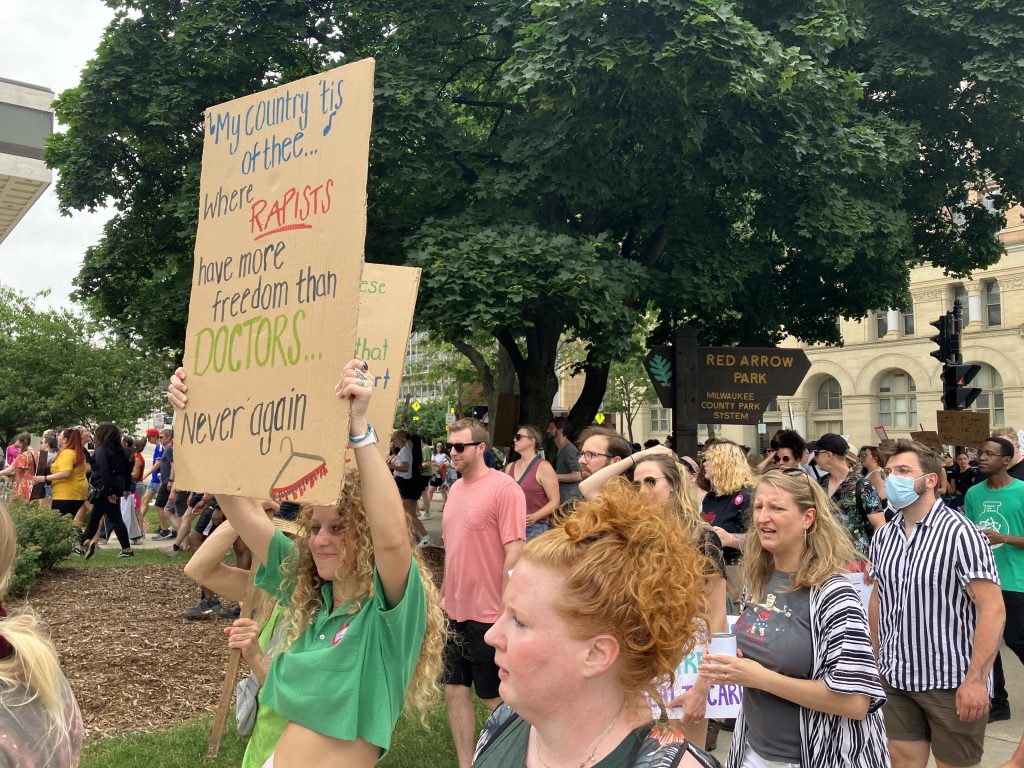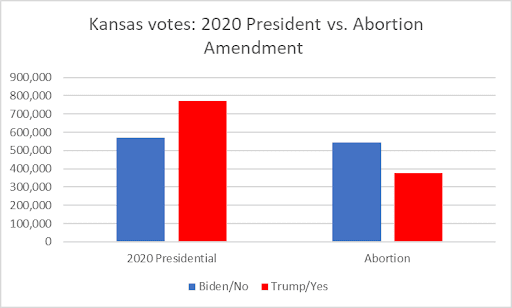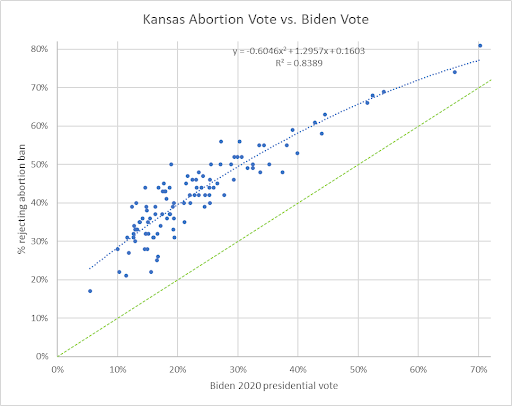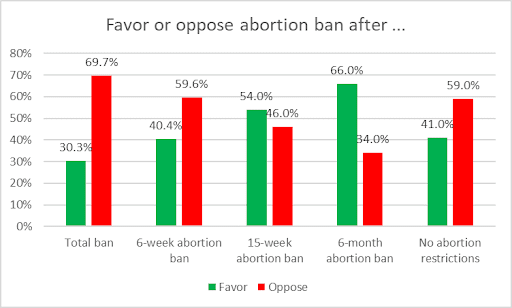What Does Kansas Abortion Vote Mean for Wisconsin?
Kansas vote shows abortion still a partisan issue. But abortion bans are widely unpopular, even in conservative states.
The results of the recent vote in Kansas to amend the states constitution came as a surprise to many observers. The graph below shows the reasons for the surprise.
The left-hand pair of columns shows the number of votes Kansas gave to each of the major party candidates in the 2020 presidential election. The total for Joe Biden is shown in blue; that for Donald Trump in red. In 2020, Kansas voters lived up to their reputation as conservative voters. Biden lost Kansas by a vote of 42.5% to 57.5%, a 15-percentage point gap.
By comparison, consider the recent vote totals on a proposal to amend the state constitution to permit laws that would severely restrict or ban abortions in Kansas. As the two columns on the right show, the amendment went down to defeat by a vote of 59.0% to 41.0%, a difference of about 18 points.
Aside from the expectation that the overall conservatism of Kansas voters favored the constitutional amendment, its timing seemed to favor it. It was scheduled to be voted on along with primary elections, rather than the general election when higher turnout was expected, particularly among Democratic voters. In addition, all the competitive races were in the Republican primary.
Yet, as the above graph shows, the No vote was only slightly smaller than the Biden vote two years earlier. By comparison, the Yes vote, against abortion, was less than half the vote for Trump. Does this imply that support for abortion has become less partisan?
The horizontal (x) axis in the graph shows the percentage of each county’s vote that was won by Biden. The vertical (y) axis shows the percentage of each county’s vote that rejected the proposed amendment.
The green dashed line (the diagonal) compares the two votes. Note that every county falls above this diagonal, meaning that in every county, a higher percentage of voters rejected the proposed amendment than the percentage that voted for Biden.
The blue dashed line is the trend line. It predicts the percentage of the No vote for each county, based on the percentage of its vote for Biden (B). As the graph shows, the stronger the pro-Biden vote in a county, the stronger that county’s opposition was to amending the constitution.
This equation can be used to predict how other states would react to a proposed amendment like the Kansas proposal. Based on the assumption that the relationship between the county presidential vote and a referendum vote on abortion bans is like that of Kansas counties, the predicted outcome for Wisconsin is that 66% of voters would reject a ban on abortion.
Apparently using calculations similar to the one here, an article in the New York Times calculated that, based on the Kansas results, a similar referendum would enjoy majority support in only seven states (five in the south plus Wyoming and Utah).
However, not every abortion opponent agrees with that strategy. Consider an article with the title A Political Crisis of the Republican Party’s Making in The American Conservative. The author starts by asserting that “in the weeks since the Supreme Court overturned Roe v. Wade, Democrats have spent millions of dollars telling voters that the first thing Republicans will do if they take power is to ban every single abortion nationwide–including when the mother’s life is in danger.” I should note in passing that Republican politicians, particularly governors, have done a very effective job of reinforcing the Democratic message.
He then goes on to advocate that the Republicans put forward a bill of their own, with an abortion ban kicking in at 6 or 15 weeks. He claims that the “Democrats have all publicly committed themselves to one of the least popular abortion agendas possible—legal up until the moment of birth, including partial-birth …”
Those claims appear to stem from a misreading of HR 3755, the Women’s Protection Act, which incorporates the consensus of Democrats in Congress. This bill passed the House and has moved to the Senate, where it is likely to die.
HR 3755 protects a woman’s right to an abortion up to viability (generally considered around 22-24 weeks). After that, HR 3755 protects the right to abortion only if needed for the woman’s life or health. Thus, a state would be free to ban or otherwise regulate post-viability abortions.
The next graph summarizes the findings of the Marquette Law School national poll which asked respondents whether they supported or opposed an abortion ban depending on a fetus’ development. The green columns show the percentage of voters who favored or strongly favored the ban; the red columns represent those opposed or strongly opposed to the ban. The strongest support was for a ban after 6 months, very close to the current estimates of viability.
The good news coming out of Kansas for Wisconsin is the unpopularity of abortion bans even in quite conservative states. Even many people who do not like abortion feel queasy about government taking over this very personal decision. Strikingly, opponents of the amendment were able to build on this reluctance (see here and here).
The bad news is that, particularly with Wisconsin’s very gerrymandered legislature, it is currently hard to imagine how Wisconsin voters can transform the public consensus into law.
If you think stories like this are important, become a member of Urban Milwaukee and help support real, independent journalism. Plus you get some cool added benefits.
Data Wonk
-
Life Expectancy in Wisconsin vs. Other States
 Dec 10th, 2025 by Bruce Thompson
Dec 10th, 2025 by Bruce Thompson
-
How Republicans Opened the Door To Redistricting
 Nov 26th, 2025 by Bruce Thompson
Nov 26th, 2025 by Bruce Thompson
-
The Connection Between Life Expectancy, Poverty and Partisanship
 Nov 21st, 2025 by Bruce Thompson
Nov 21st, 2025 by Bruce Thompson






















